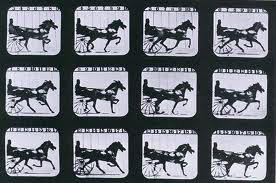

Frame rate, or frame frequency, is the frequency (rate) at which an imaging device produces unique consecutive images called frames. The term applies equally well to computer graphics, video cameras, film cameras, and motion capture systems. Frame rate is most often expressed in frames per second (FPS), (fps) and in progressive scan monitors as hertz (Hz).
There are currently (2010) three main frame rate standards in the TV and movie-making business: 24p, 25p, and 30p. However there are many variations on these as well as newer emerging standards.
*50i (50 interlaced fields = 25 frames) is the standard video field rate per second for PAL and SECAM television.
*60i (actually 59.94, or 60 x 1000/1001 to be more precise; 60 interlaced fields = 29.97 frames) is the standard video field rate per second for NTSC television (e.g. in the US), whether from a broadcast signal, DVD, or home camcorder. This interlaced field rate was developed separately by Farnsworth and Zworykin in 1934, and was part of the NTSC television standards mandated by the FCC in 1941. When NTSC color was introduced in 1953, the older rate of 60 fields per second was reduced by a factor of 1000/1001 to avoid interference between the chroma subcarrier and the broadcast sound carrier.
*30p, or 30-frame progressive, is a noninterlaced format and produces video at 30 frames per second. Progressive (noninterlaced) scanning mimics a film camera's frame-by-frame image capture. The effects of inter-frame judder are less noticeable than 24p yet retains a cinematic-like appearance. Shooting Video in 30p mode gives no interlace artifacts but can introduce judder on image movement and on some camera pans. The widescreen film process Todd-AO used this frame rate in 1954–1956.
*The 24p frame rate is also a noninterlaced format, and is now widely adopted by those planning on transferring a video signal to film. Film and video makers use 24p even if their productions are not going to be transferred to film, simply because of the on-screen "look" of the (low) frame rate which matches native film. When transferred to NTSC television, the rate is effectively slowed to 23.976 frame/s, and when transferred to PAL or SECAM it is sped up to 25 frame/s. 35 mm movie cameras use a standard exposure rate of 24 frames per second, though many cameras offer rates of 23.976 frame/s for NTSC television and 25 frame/s for PAL/SECAM. The 24 frame/s rate became the de facto standard for sound motion pictures in the mid-1920s.
*25p is a video format that runs twenty-five progressive frames per second. This frame rate derives from the PAL television standard of 50i (or 50 interlaced fields per second). Film and Television companies use this rate in 50 Hz regions for direct compatibility with television field and frame rates. Conversion for 60 Hz countries is enabled by slowing down the media to 24p then converted to 60 Hz systems using pulldown. While 25p captures half the temporal resolution or motion that normal 50i PAL registers, it yields a higher vertical spacial resolution per frame. Like 24p, 25p is often used to achieve "cine"-look, albeit with virtually the same motion artifacts. It is also better suited to progressive-scan output (e.g., on LCD displays, computer monitors and projectors) because the interlacing is absent.
*50p and 60p is a progressive format used in high-end HDTV systems. While it is not technically part of the ATSC or DVB broadcast standards, it is rapidly gaining ground in the areas of set-top boxes and video recordings.
*72p is currently an experimental progressive scan format. Major institutions such as Snell & Wilcox have demonstrated 720p72 pictures as a result of earlier analogue experiments, where 768 line television at 75 Hz looked subjectively better than 1150 line 50 Hz progressive pictures with higher shutter speeds available (and a corresponding lower data rate). Modern cameras such as the Red, can use this frame rate to produce slow motion replays at 24 frame/s. Douglas Trumbull who undertook experiments with different frame rates which led to the Showscan film format, found that 72 frame/s was the maximum frame rate at which emotional impact peaked for viewers. 72 frame/s is the maximum rate available in the WMV video file format.
*Higher frame rates including 300 Hz have been tested by BBC R&D over concerns with sports and other broadcasts where fast motion with large HD displays could have a disorientating effect on viewers. 300 frame/s can be converted to both 50 and 60 Hz transmission formats without major issues.
Owing to their flexibility, software-based video formats can specify arbitrarily high frame rates, and many (cathode ray tube) consumer PC monitors operate at hundreds of frames per second, depending on selected video mode. LCD screens are usually 24, 25, 50, 60, or 120 frame/s.
Video Converter Factory Pro; it is a related video tool that can help you get the right video format that you need. Video Converter Factory Pro is safe and has powerful converting functions, fast converting speed and easy operation. In addition to these advantages, its rich parameter settings also can help you set the related parameters like the display resolution, bit rate, encoder, and frame rate and so on.
Resolution Video Encoder Audio Encoder Aspect Ratio Video BitRate Audio BitRate Frame Rate Audio Channels Sample Rate Video Profile Decoder Codec
AVI MP4 MKV Video 3GP FLV MP3 Aspect Ratio 1920*1080 H264 MPEG-4 AVC AVCHD DTS TS FFDShow AAC HD Video Resolution QuickTime Video Encoder Audio BitRate Video BitRate Audio Channels Frame Rate Sample Rate Video Profile iPad iPod PSP iPhone Android Symbian DVD NTSC HD Video Flash FLV SWF YouTube WMV TS Video Editor Video Converter